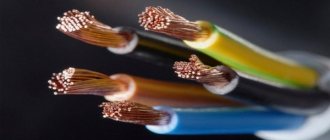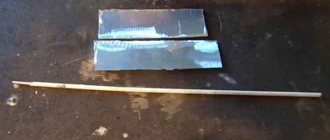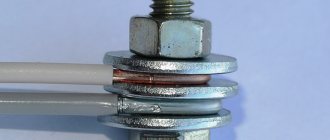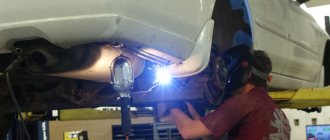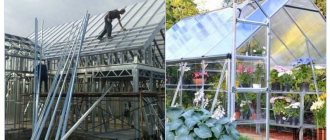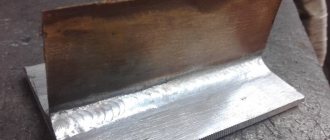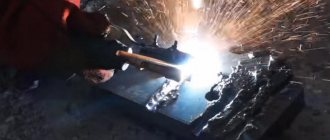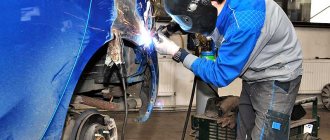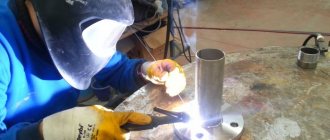Anyone can independently install electrical wiring with copper cores. According to the rules, the wires are connected with terminals, soldered or welded. It is more convenient to use a device for welding copper wires in distribution boxes and panels. The copper twist melts in a matter of seconds under the action of an electric arc. After this she is isolated. Such a connection will last a long time and will not create additional resistance.
Having a small welding device at home, you can carry out third-party orders for the installation or repair of copper wires. Many craftsmen make welders themselves.
Using an inverter
Copper wires, most common in residential buildings, are connected in several ways, but welding is considered the most reliable.
As a result of this connection, a homogeneous conductor is obtained, which ensures complete fire safety. Welding is carried out with direct or alternating current voltage from 12 to 36 V, and the welding current must be adjusted. Most welding inverters meet these requirements. They produce a special apparatus for welding copper wires, which is used by electricians. It has a power range of 1-1.5 kW and welding current adjustment in the range from 30 to 120 A.
Unlike conventional inverters, the equipment has less weight and dimensions; in addition, the ends of the welding cables are equipped with a special holder for carbon electrodes and a clamp with a large clamping surface for the conductors. If the farm already has an inverter welding machine, then you don’t need to buy a special device for welding copper wire.
For convenience, pliers and an electrode holder are welded to the welding cables or attached through a bolted connection. Any powerful clamp can play the role of a carbon electrode holder. Its handles must first be insulated.
The pliers are attached to the ground wire. They will hold onto the twist of the copper conductors being welded, while they will perform the important function of heat removal. This is necessary to protect the insulation from exposure to high temperatures.
Soldering. Connecting wires by soldering.
Soldering is a method of joining metals using another, more fusible metal. Compared to welding, soldering is simpler and more affordable. It does not require expensive equipment, is less fire hazardous, and the skills needed to perform good quality soldering will require more modest skills than when making a welded joint. It should be noted that the metal surface in air is usually quickly covered with an oxide film, so it must be cleaned before soldering. But the cleaned surface can quickly oxidize again. To avoid this, chemicals are applied to the treated areas - fluxes, which increase the fluidity of the molten solder. This makes the soldering stronger.
Soldering is also the best way to terminate copper strands into a ring - the soldered ring is evenly coated with solder. In this case, all wires must completely fit into the monolithic part of the ring, and its diameter must correspond to the diameter of the screw clamp.
The process of soldering wires and cable cores consists of covering the heated ends of the connected wires with molten tin-lead solder, which after hardening provides mechanical strength and high electrical conductivity of the permanent connection. The soldering must be smooth, without pores, dirt, sagging, sharp bulges of solder, or foreign inclusions.
To solder copper conductors of small cross-sections, use solder tubes filled with rosin, or a solution of rosin in alcohol, which is applied to the joint before soldering.
To create a high-quality soldered contact connection, the wire (cable) cores must be thoroughly tinned, and then twisted and crimped. The quality of the soldered contact largely depends on correct twisting.
After soldering, the contact connection is protected by several layers of insulating tape or heat shrink tubing. Instead of insulating tape, the soldered contact connection can be protected with an insulating cap (PPE). Before this, it is advisable to coat the finished joint with a moisture-resistant varnish.
Heating of parts and solder is carried out with a special tool called a soldering iron. A prerequisite for creating a reliable connection using soldering is the same temperature of the surfaces being soldered. The ratio of the temperature of the soldering iron tip and the melting temperature is of great importance for the quality of soldering. Naturally, this can only be achieved with the help of a properly selected tool.
Soldering irons vary in design and power. To perform household electrical work, a conventional electric rod soldering iron with a power of 20-40 W is quite sufficient. It is advisable that it be equipped with a temperature regulator (with a temperature sensor) or at least a power regulator.
Experienced electricians often use an original method for soldering. In the working rod of a powerful soldering iron (at least 100 W), a hole with a diameter of 6-7 mm and a depth of 25-30 mm is drilled and filled with solder. In a heated state, such a soldering iron is a small tin bath, which allows you to quickly and efficiently solder several multi-core connections. Before soldering, a small amount of rosin is thrown into the bath, which prevents the appearance of an oxide film on the surface of the conductor. The further soldering process involves lowering the twisted connection into such an improvised bath.
Process modes and features
Due to the limited welding currents, devices for fusing electrical wires can have very small sizes. Thermite welding of wires, which is widely used among specialists and is organized using a special powder mixture, makes it possible to further simplify the welding procedure. In this case, it is possible to significantly reduce the dimensions of the portable equipment used.
When carrying out ordinary electrical operations (including welding copper and aluminum wires), special equipment is used, which uses direct current of direct polarity to form an arc. The plus of the supply circuit is connected to the electrode holder in such a device, and its minus is connected to the grounding wire, which is usually called “ground”.
When welding with certain types of copper-coated electrodes, reverse polarity is used.
The magnitude of the welding current in any case is determined by the dimensions of the electrical wire harness being installed and the cross-section of the individual cores collected in it. During the welding process, the required value of this parameter is set using a regulator located on the control panel.
Various models of small-sized welded units provide adjustment of the output voltage. Some manufacturers and even home craftsmen further improve the design of their models by installing special current limiters in them. Data on the output parameters of such devices can be found in the tables of the dependence of the operating voltage and current on the cross-section of the wires being welded and their number in the twist.
Inverter Welding Basics
For beginners, experienced welders advise attaching the holder cable to the body, pressing it with the elbow of the arm and wrapping it along the forearm (from the elbow to the hand), and taking the holder in your hand. This way the shoulder joint will pull the cable, and the arm and hand will remain free.
The method will help you manipulate your hand with ease.
Correct placement of the cable on the forearm. You should not work with bare hands.
If you simply take the holder in your hand without wrapping the cable around your forearm, then during the welding process your hand will get tired and wrist movements will cause the cable to dangle. Which will affect the quality of the welded joint.
How to cook using inverter welding correctly? We set the welding current on the machine according to the diameter of the electrode, the type of connection and the welding position. Setup instructions are available on the device and the electrode pack. We take a stable stance, move our elbow away from the body (no pressing), put on a mask and begin the process.
For beginners, it is better to start welding with an inverter with metal workpieces larger than 20 cm.
It is known that a beginner, putting on a mask and lighting an arc, stops breathing, trying to boil the entire length of the workpiece in one breath. With short products, you will develop the habit of cooking in one go. Therefore, practice on long workpieces, learning to breathe properly when welding.
Workpieces (plates) on the work table can be placed in a horizontal plane - vertically towards you or horizontally, it makes no difference.
At the beginning of welding, place the electrode clamped in the holder at an angle of 90 degrees (perpendicular) and move it towards the seam by 30-45 degrees. Light the arc and start moving.
- If welding is performed at an angle backwards, then the tilt of 30-45 degrees goes towards the seam.
- If the connection occurs at an angle forward, then the electrode is tilted away from the seam.
The distance between the surface to be welded and the electrode is 2-3 mm, imagine that you are running a pencil along a sheet of paper.
Please note that when welding, the electrode decreases as it burns - gradually bring the melting rod closer to the surface at a distance of 2-3 mm and maintain an inclination angle of 30-45 degrees.
Watch a useful video on how to learn how to weld with electric welding for beginners:
Pros and cons of welding, its varieties
The advantages of connecting wires by welding are the absence of transition resistance, which is always present in twisted or bolted connections. This is especially true when laying wiring for powerful devices. The disadvantages are the need to buy or make your own welding machine designed for twisting.
Welding work requires some skills, so the electrician who will weld the strands needs to learn at least the basics of this craft.
When performing electrical installation work in production, various types of welding are used: standard, arc spot, plasma, torsion, electron beam, ultrasonic, or various combinations thereof. For domestic use, electricians most often use a device for spot and arc welding, which operates on carbon or graphite electrodes.
This solution allows you to obtain good quality connections at a minimum cost of the necessary devices and components. When making a wire welding machine, most attention should be paid to the following characteristics of the device:
- The current strength that the device can produce. Ideally this is a variable value.
- The voltage produced by the device is sufficient to cause an electric arc - usually 12-32 Volts.
- What kind of current does the welder use - alternating or direct? If you have experience in such work, you can use variable, but for beginners it is strongly recommended to start with constant.
Since welding different metals requires different currents and voltages, universal welding machines can necessarily adjust these values. In addition, when joining different materials, you may need special fluxes that will protect the metal from oxidation or the penetration of gases from the air into it. Most universal-purpose welding machines are quite bulky and heavy, but for small welding jobs you can find inverter welders for a relatively low price that are ideal for welding wires.
If you are welding copper wires that are used in home wiring, there is no need to use very high current and voltage, so it is possible to use small-sized welding machines that fit into a standard tool case.
Stages of preparation for welding
Finding out how to learn to cook with electric welding is not difficult, but using the acquired skills in practice is more difficult. First of all, it is important to understand that all work is divided into several stages, which include:
- selection of inverter and electrodes;
- preparation of equipment;
- welding work.
Selection of inverter and electrodes
The choice of electrodes has a direct impact on the quality of the result in the welding process.
They differ in steel grade, coating, thickness, purpose and mechanical properties. Most often, the instructions describe which electrodes are recommended to be used during the work process, but there may not be such a clause. In this case, it is important to know the basics of their choice. When choosing electrodes, it is important to pay attention to the wire, which must initially be strong and of high quality. Another important component is the coating, which brings the wire to a red-hot state.
Electrodes must be selected according to the brand and type of metal required for the connection. There are many of them, not to mention situations where two different types of metal are connected.
If there is no clear data, electrodes are selected according to generally accepted recommendations, which are divided into several principles:
- carbon electrodes are used when working with medium and low-carbon steel;
- For welding alloy steel, only consumables produced in accordance with GOST 9466–75 and 10052–75 are suitable;
- For connecting cast iron parts, the OZCH-2 grade is used.
There are several hundred brands of electrodes, which are quite difficult to understand. Therefore, it is recommended to use the advice of specialists when performing welding work. For example, the universal domestic brand UONI, which is widely used in welding. To connect metal structures of low grade, quality and density, electrode brands ANO and MP-3 are used . Read more about ANO-21 in this article.
When choosing a welding inverter for use in the household, it is important to follow several rules:
- The maximum current value of the welding machine should be in the range of 160-200 A. It is better to immediately purchase powerful equipment that will allow you to connect metal products with great thickness.
- The no-load voltage parameter sometimes exceeds 90 V, but this indicator is not suitable for use in the country. It is better to choose a device with parameters in the range from 50 to 60 V.
- Duration of switching on is an important characteristic that shows how long the unit can work without a break. You should not select devices with a maximum or minimum value. It is better to take a middle ground and buy a welding machine with an PV in the range of 40-80%.
It is important to take into account the specifics of the local network.
In villages there is a problem with unstable electricity supply, not to mention weak wiring. That is why they select equipment that is capable of operating in a wide range of supply voltage without exposing itself to the risk of shutdown or failure. It is recommended to provide for a power outage and purchase a device capable of operating from a centralized network and autonomous sources using gasoline or diesel fuel.
Features of using carbon electrodes
The electrodes are made from black electrical carbon pressed into a rod shape. Its ends are beveled. Even with a very low welding current, a high temperature occurs at the tip of the electrode.
A carbon electrode is used when it is not possible to weld with a graphite element. You need to work very carefully to prevent the insulation from overheating. Carbon electrodes are commonly used in low power welders.
When working with carbon electrodes, the following features must be taken into account:
- the welding site is fragile , can oxidize and have a porous structure;
- Due to the high arc temperature, the electrode is consumed faster;
- It is more difficult to work with a carbon rod electrode than with a graphite electrode ; practical skills are required.
The principle of operation of arc welding - device diagram
Since welding requires a large current, the basis of any welding machine is a step-down transformer - a loss in voltage is always accompanied by a gain in current and vice versa. A standard diode bridge is used to convert alternating current into direct current, and a capacitor is used to smooth out ripples.
A noticeable disadvantage of using a direct current device is that the diodes and capacitor used are rather large and they significantly increase the weight of the welding machine, which is initially made portable.
Experts also recommend installing additional resistance at the input or output of the diode bridge, since diodes “do not like” a short circuit in its pure form.
Many craftsmen manually assemble a welding machine for welding copper wires, which produces an arc from alternating current and use them successfully. Therefore, it is impossible to say unequivocally that it is necessary to use a direct current device - everyone chooses the necessary model according to their skills. If an AC welding machine is manually assembled, then the diode bridge and capacitor are simply thrown out of the circuit.
A necessary skill that you will have to master to use an AC welding machine is to learn “by eye” to determine how long you should hold the ignited arc of the electric discharge so that the end of the twist heats up and fusions.
The most common way to make a negative contact for welding is with old pliers that hold the wires.
For the phase, take a clamp that can hold the graphite rod. The design of the clamp can be very diverse - from a screw connection to the so-called “crocodiles”, both home-made and factory-made. To connect to the welding machine itself, cables with a cross-section of about 10 mm² are used.
Despite the fact that a device assembled in an industrial environment is an order of magnitude more expensive than a homemade one, its price is not exorbitant and allows you to purchase such a welding machine even on a limited budget. The advantages of its use are obvious - it is a precisely calculated design with a current regulator, which allows you to work with different types of metals and the number of wires being welded.
How are twisted wires welded?
- It is necessary to remove 50-60 mm of insulation from the wires and twist them.
- Use pliers or clamps to connect the twist to the mass.
- Electrode for 1 sec. scald the end of the twist to a ball at the end.
- Cool and isolate the twist.
Who can weld copper wire strands? Theoretically, anyone, as long as there was an understanding of electricity and electrical installation. Still, it is better to have a professional electrician do the welding of twisted copper wires. You need to pay attention not to burn the insulation of the wires, so that the twist is not short, but a drop of welding, if possible, without holes.
Who can weld copper wire strands
Features of wire welding
First you need to make the correct installation of the wiring - choose its optimal diameter, correctly position it in the walls of the room. To distribute lines, special boxes are installed. There it becomes possible to redirect the supply of electricity from the central wire to the auxiliary one.
Welding wires in a box has the following nuances:
- Use of inverter welding machines with power up to 1 kW. These can be factory models or homemade ones.
- Electrodes - graphite or carbon. It is not recommended to use copper-plated rods, as this may affect the quality of the connection.
- Unlike soldering, no flux or other types of additives are required during welding.
- Wire heating temperature control. Otherwise, there is a high probability of partial destruction or change in the properties of the insulation.
Work is carried out only when the network is completely de-energized; a protective mask and special work clothing are used during welding. The diameter of the electrodes depends on the calculated current strength, which, in turn, is calculated depending on the diameter of the cores and their number.
Soldering or welding copper wires - which is better?
The simplest and most effective soldering method is to immerse the contact point in molten solder. For small circuits this method is suitable. But it is not suitable for installing lines made of copper wires. Soldering with tin solders by weight requires skill; beginners cannot cope with such work, and there is a high risk of injury. Connecting wires with your own hands using contact welding is much safer.
Another advantage of welding is that the chemical composition of the wires does not change, and no solder particles get into the alloy. The electrical conductivity of the copper cable at the point of twisting does not change. Welding is faster than soldering; there is no need to pre-tin the contacts or select a soldering iron according to the power of the cable size. There are multi-core cords that cannot be soldered.
Welding has the only drawback: if you do not have the skills, you can damage the integrity of the insulation of the copper wire.
Features of welding aluminum wires
The use of aluminum cores is prohibited by the current PUE. But in some older homes you can still find this type of wiring. A complete replacement entails financial costs and can take a long time. But for welding aluminum wires it is necessary to take into account a number of specific points.
They are as follows:
- cleaning contact parts from oxide film;
- use of special flux for aluminum welding;
- treating the welding area after cooling with quick-drying varnish.
The use of mechanical types of connections for aluminum wires is not recommended. Also, you cannot twist wires made of this material with copper ones. To do this, use special adapters.
Selecting Electrodes
In addition to the welding unit, for electrical work you will need special electrodes suitable for the selected wire processing mode. Most often, copper rods of a special design with graphite or coal additives are used for these purposes.
To obtain a high-quality and reliable connection during its formation by electric welding, special filler and activating additives (fluxes, in particular) are necessarily used. In addition, this will require the following auxiliary and consumable materials:
- insulating tape;
- well-sharpened mounting knife;
- side cutters or pliers.
After preparing a complete set of tools, you can safely begin welding activities.
Alternative connection methods
It is not always possible to weld current-carrying conductors. Difficulties are caused by the lack of an inverter (welding machine) or insufficient experience in performing this type of work. In this case, it is recommended to consider alternative wire connection options.
Methods for forming reliable contact between several cores:
- Twisting (crimping). It differs from the process described above in the absence of a welded joint. It is not recommended to do this, since there is a high probability of lack of direct contact between several wires, which can lead to a resistive effect - heating.
- Soldering. Unlike welding, solder and flux are used. They should fill the space between the twisted wires. Convenient for connecting small cross-section cores.
- Contact clamps. They can be screw or mechanically fixed. The former are used for switching a large number of wires. Mechanical fixation is recommended for connecting large diameter cores for networks with a high load rating.
For each technique, an individual procedure for performing work is adopted. But in any case, generally accepted safety rules are followed.
Crimping with a sleeve
Crimping with copper or brass sleeves is one of the most reliable mechanical connection methods. This method is also applicable for connecting wires in electrical panels. The principle of connecting using this method is simple for the general concept - it is crimping the wires inserted into the sleeve with special press pliers. The connected cores must first be stripped with a length slightly larger than the sleeve itself. Pre-twisted wires are placed inside and, depending on the length of the sleeve, crimped in several places. The sleeves can be: copper, brass made from an alloy of brass and aluminum, tinned brass or copper.
Advantages of this method:
- Connection reliability;
- Speed, independence from the existing network;
- Quick visual control of heating.
The disadvantages include:
- Availability of sleeves of various diameters and special crimping devices;
- Permanent connection of large lengths of connected wires;
- The relative cost of the procedure;
- Increasing the volume of the connection and the need to insulate the sleeve.
Types of electrodes
Round
The simple “round” type can be used indefinitely. The cross-section of the rod ranges from 3.2 to 19 mm. There are also so-called “round endless” electrodes. Of course, they have strictly limited sizes. However, the efficiency fully justifies the main name.
The diameter of the “endless” elements varies from 8 to 25 mm. Most often they are used when welding using a special machine. Both options are acceptable for “simple” welding work. However, any types of coal models, due to their infusibility, consume little.
There are also several types of such electrodes that deserve separate analysis.
Semicircular
The semicircular electrode usually has a diameter of 10 to 19 mm. Such products are often recommended for cutting metal workpieces. It is semicircular electrodes that are used by most amateur and professional welders. The seam has an optimal shape. Creating an edge with a semicircular electrode is easy.
Rectangular
They are also sometimes called flat - but not everything is so simple. When traders say the word “flat”, they may also mean square. The section size ranges from 8 to 25 mm. Most often, such tools are used when it is necessary to repair a defect in a steel casting. They are rarely used for other purposes.
Hollow
It is not often possible to find this type of electrodes. Their typical size ranges from 5 to 13 mm. It is this solution that is suitable for forming U-shaped outline lines. Hollow structures are also excellently used for vacuum welding. The pressure in the working chamber should not exceed 665 Pa.
Connecting wires with connecting insulating clamps
One of the popular connecting products among electrical installers is the connecting insulating clamp (PIC) . This clamp is a plastic case, inside of which there is an anodized conical spring. To connect the wires, they are stripped to a length of about 10-15 mm and folded into a common bundle. Then the PPE is screwed onto it, rotating clockwise until it stops. In this case, the spring compresses the wires, creating the necessary contact. Of course, all this happens only when the PPE cap is selected correctly according to its rating. Using such a clamp, it is possible to connect several single wires with a total area of 2.5-20 mm2. Naturally, the caps in these cases are of different sizes.
Depending on the size, PPE has specific numbers and is selected according to the total cross-sectional area of the strands being twisted, which is always indicated on the packaging. When choosing PPE caps, you should focus not only on their number, but also on the total cross-section of wires for which they are designed. The color of the product has no practical meaning, but can be used to mark phase and neutral conductors and ground wires.
PPE clamps significantly speed up installation, and due to the insulated housing, they do not require additional insulation. True, their connection quality is somewhat lower than that of screw terminal blocks. Therefore, other things being equal, preference should still be given to the latter.
Graphite electrode for welding
Due to its technical characteristics, the graphite electrode is easy to cut, consumes more slowly, and does not crack during welding. As practice shows, welding of wire cores is carried out in distribution boxes. The boxes are located quite high, so you will need to use portable welding equipment for welding.
Industrial devices are used for these purposes, the use of which is advisable in a professional sense. If possible, you can assemble the welding machine yourself. However, for most people, inverter-type devices, which are presented in a large assortment in stores, are perfect. They are compact, mobile, lightweight and also have the ability to adjust the welding current you need.
Types of electrodes for welding copper wire cores
When welding copper conductors, appropriate electrodes must be used. We have already mentioned carbon electrodes. There is also a graphite type of electrodes. Battery rods, brushes of commutator motors and similar products made of graphite can be used as an electrode in household use.
Graphite rods are a good replacement for purchased electrodes, with the only exception that they do not have copper plating, but this can be solved by improving the holder. To do this, it will be necessary to use an alligator clip, both for the electrode and for the ground connection. They will not be as bulky as standard ones, so it will be more convenient for you to work in switchboards. Of course, you will need to take care of additional insulation of the handles.
Graphite and carbon electrodes have a general similarity: both have a melting point 4 times higher than the melting threshold of copper itself. Because of this property, the consumption of electrodes when connecting electrical wiring is very low.
Please note that the electrode heats up to a high temperature instantly, so there is a risk of overheating the material being welded, which, in turn, can damage the insulation in the cable. The welder needs to know these factors in order to be careful when installing electrical wiring.
Differences between graphite and carbon electrodes
Despite the similarity of graphite and carbon rods when installing wiring, their characteristics differ:
- The first difference is the price. Graphite products are more affordable;
- if the carbon rod is completely black, then the graphite electrode has a gray-dark color with a metallic tint;
- welding using a carbon electrode requires a certain skill from the welder, since the carbon rod creates an arc of enormous temperature, which can lead to the destruction of the welded twist. At the same time, huge temperature indicators occur at low current. Based on this, carbon electrodes will be useful to a welder with a weak welding machine;
- for those who own an inverter device that is equipped with a current regulator, it is better to use graphite rods. When working with them, less skilled craftsman is required. In addition, the connection of wire cores after their use is characterized by greater strength, better quality, and increased resistance to oxidation than after the carbon welding process.
How does the welding process take place?
The process itself consists of several main stages that everyone who is going to do this simple task needs to know. Welding stages during connection of twists:
Materials for the manufacture of a welding machine for twisting.
- You need to take a kitchen knife or a special construction knife, and then carefully trim the wire sheath and remove the centimeters you need.
- To create twists, we take several strands and twist them about three centimeters long.
- You need to put a clamp on the place where you want to solder and connect the ground of the welding machine.
- It is necessary to set the current strength on the welding machine and wait until the electrode heats up to the desired temperature.
The welding process itself will take you just a couple of seconds. In this short period of time a small ball of copper should form. If you wait for the set time, the ends of the wire will simply melt and become very brittle. After the work process is completed, you will need to insulate the bare wires, and then connect the voltage.
What kind of lighting do you prefer?
Built-in Chandelier
Assembly instructions
Assembling the device with your own hands will require minimal skills in working with hand tools. For convenience, the manufacturing process should be divided into 5 stages:
- Preparing the body. It is selected based on the dimensions of the transformer.
- Search and installation of a transformer. Checking its performance.
- Selection of power cable. Protection of the device from overload.
- Installation of output terminals. Other connection methods.
- Selection and installation of holder and electrode. DIY alternatives.
Welder body
The easiest way is to use a ready-made housing from any electrical device. For example, from a car charger or a suitable uninterruptible power supply from a computer. It is desirable that the housing be made of dielectric material (plastic, carbolite). This will be a plus in favor of the security of the future device. If none of the above options is suitable, then the easiest way is to make a body from thin sheet iron 1-3 mm thick.
Transformer selection
The required transformer can sometimes be found in stores. Another option is to look for it from friends or wind it yourself.
The primary winding of the transformer is designed for 220 V. The iron is selected based on the overall power of 200-1000 W. Low-power transformers are suitable for welding thin wires, and high-power transformers are suitable for thick ones.
The secondary winding of the transformer is wound with wire from 35 kW. mm, because she will have to experience short circuit currents. It is better to use copper as the material for the output winding. This will reduce heating losses.
Power cables
The 220 V power supply cable is selected based on the power of the transformer. For devices with a consumption of 1 kW, its cross-section is taken to be at least 4 square meters. mm. A thick cable is also better because it is more difficult to break or break during repairs and wiring.
To protect the device, it would be useful to install a fuse or circuit breaker in the primary winding circuit. This way the transformer will be protected from overcurrent.
Terminal Applications
If possible, the use of terminals should be avoided. They tend to become loose and burn over time, especially at high currents in the secondary winding of the transformer. The most reliable connections are made by welding, soldering or crimping.
In some cases, terminals are convenient. For example, at the output of a welding transformer. Using terminals, you can move the device separately from its wires. The main thing is to ensure that during operation the terminals do not oxidize, dangle or overheat. It is permissible to periodically remove dirt using a file.
Electrode holder
Welding is carried out with a graphite electrode coated with a thin layer of copper. This combination provides the good conductivity of copper combined with the heat resistance of graphite. Similar electrodes are commercially available. If you couldn’t find them, you can make them yourself from a graphite brush of an electric motor. It should be taken larger and cut with a hacksaw to the desired size.
Homemade holders for welding. The holder is made of a pair of copper bars and bolts for tightening. The device must securely clamp the graphite electrode.
Recommended welding current modes for different conductors
The magnitude of the welding current depends on the cross-section size and the number of strands in the twist: the thicker the twisted bundle, the greater the current value must be set on the welding machine:
- 2 cores, cross section of each 1.5 mm² - 70 A;
- 3 cores, cross section of each 1.5 mm² - 80-90 A;
- 2-3 cores, cross section of each 2.5 mm² - 80-100 A;
- 3-4 cores, cross section of each 2.5 mm² - 100-120 A.
The specified welding current modes are indicative. Wires from different manufacturers differ in chemical composition and declared cross-section, and welding devices also differ in their characteristics. Therefore, it is better to select the value of the welding current practically on a small section of the same wire. When choosing a mode experimentally, the optimal one will be when the arc is stable and the tip of the electrode does not stick to the welding site.
For modern inverter-type devices:
- stable welding discharge, ensuring high-quality welding work;
- When welding, liquid metal does not splash;
- the arc does not blind the welder due to the low melting point of copper;
- inverters are not heavy, their dimensions are small, which allows them to be carried to the installation site on a belt.
Contact method
In addition to using an inverter for welding copper wires, spot contact welding can also be used, the welding time of which does not exceed 1-2 seconds.
At home, to connect household electrical wiring, you can use a conventional 500 W transformer with a voltage in the secondary winding of 12-36 V. By attaching a holder for the electrode and copper wires to the secondary winding, we get a simple welding machine.
Depending on the cross-section and number of copper wires, it has been experimentally established that the current for welding should be:
- for 2 wires with a cross section of 1.5 mm2 – 70 A;
- 3 sections 1.5 mm2 – 80 A;
- 3 sections 2.5 mm2 – 90-100 A;
- 4 cross-section 2.5 mm2 – 100-120 A.
However, current values can vary greatly depending on the cable used and its manufacturer. The fact is that cable manufacturers use copper wires with various impurities, which affects electrical and thermal conductivity; wire cross-sections sometimes do not correspond to the declared characteristics.
Therefore, spot welding is carried out only after the optimal welding current has been adjusted on scraps of the same cable that is to be welded.
